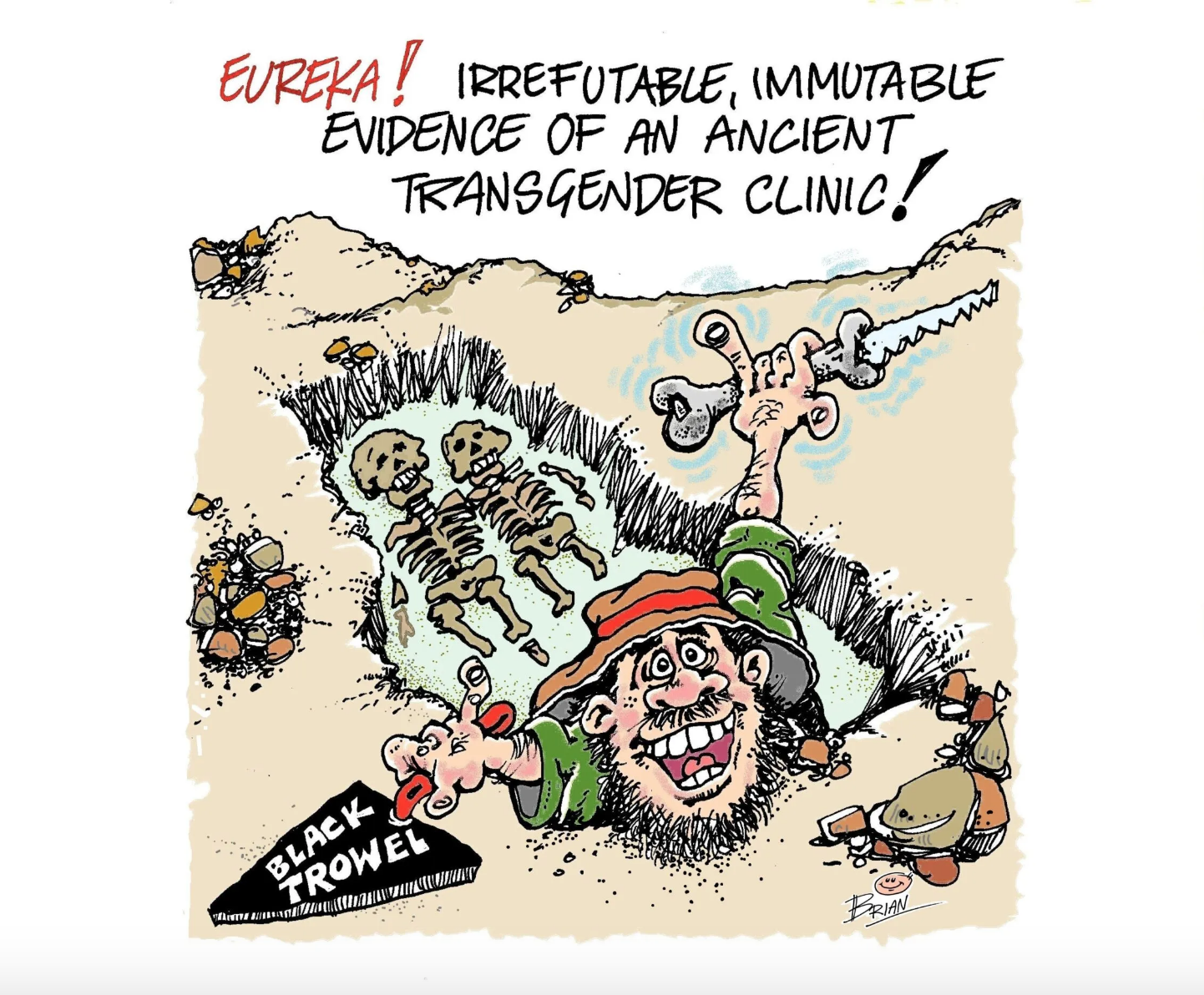Michael Cook
mercatornet.com
Michael Cook is the editor of MercatorNet. He lives in Sydney, Australia.
The Trans Revolution is like the war in Ukraine. On some fronts the Ukrainian troops creep slowly forward; on others, they retreat. Similarly, in the UK, the trans juggernaut may have ground to a halt after the closing of the Tavistock gender clinic. But in distant battlegrounds, trans activists are winning small victories in unexpected places.
Like archaeology.
Archaeology? Yes, a group called the Black Trowel Collective has issued a manifesto – Archaeologists for Trans Liberation. It calls upon colleagues to acknowledge gender fluidity in the bones found in ancient burial sites.
There is overwhelming evidence from past societies that our current ways of understanding sex and gender are fleeting and contingent. Neither sex nor gender are fixed in aspect or immutable over time and between cultures.
But it’s more like underwhelming evidence. Over the past 30 years, archaeologists have occasionally found skeletons whose social roles and sexual characteristics are confusing. A dig in Finland, for instance, uncovered 1,000-year-old bones with swords, suggesting that the person was male, and jewellery, suggesting that the person was female. A study of the badly damaged DNA suggested that the mysterious deceased might have had Klinefelter syndrome, in which a person carries the sex chromosomes XXY and may have had both male and female characteristics.
The academics who published their findings in the European Journal of Archaeology were keen to promote the notion that the person may have been intersex. But their analysis contains so many maybes and possiblys that its value as evidence of a trans culture in the ancient world is zilch.
Another example cited by trans archaeologists is the “Lovers of Modena”. In 2009, archaeologists in Modena, Italy, uncovered a 1500-year-old grave with two skeletons which appeared to be holding hands. In 2019, an analysis of their tooth enamel suggested that they were both male. Aha! Gay lovers! Or, more likely, brothers, or cousins or fellow soldiers.
Whilst the manifesto of a few “anarchist archaeologists” may not seem like a hill to die on, archaeology is an important battleground. (For further reading on the topic, consult the website of Queer Archaeology.)
The trans narrative is that trans people have always existed and that they have been made invisible by the oppressive cis-normative bigotry of Western culture and a Christian moral code. If burial sites yield evidence that pre-industrial, pre-Christian societies happily accepted trans folk, then gender fluidity must be natural and good and must be protected.
And, as a matter of fact, it is not just the crazies on Twitter who are defending the Eternal Trans; serious academics are also attempting to make it credible. The Finnish and German scientists who analysed the Suontaka grave preface their study with this remark: “The binary division of sexes is arguably rooted in a modern, Western mindset and gendered norms and expectations have varied culturally, geographically and temporally.”
Which is basically the argument of the Black Trowel Collective, an argument which threatens to revolutionise the study of history itself.
Traditionally historians have studied the evidence of the past to identify perennial values in human nature and society. The most fundamental of these are the man-woman binary and the family. In every society which has ever existed, mother, father, child and family are the ridgepoles and canvas protecting the advance of humanity. Historians who do not accept these as the interpretative key to understanding human experience will turn the dim and fragmentary evidence of past ages into something which supports their own bias.
What’s more, trans activists are determined to bully anyone who refuses to believe their myths. As the Black Trowel Collective declares menacingly:
Archaeologists, as experts in written and unwritten histories, must fight those who misrepresent the past to damage present people. It is our duty to interrupt, contradict and correct anyone who dares to rationalise their own bigotry in this way. We do this by ensuring that our scientific accounts do not reproduce transphobic and binary interpretive assumptions. Our past is diverse, multivocal and queer and we must tell these stories.
There’s another interesting twist to these attempts to defend the trans narrative based on historical evidence (however flimsy). The anarchist archaeologists at the Black Trowel Collective assert defiantly that
In essence, archaeological data allow us to perceive a past that is, like the present, culturally diverse and full of people whose own experiences of their world were shaped by their distinct social, political, and environmental contexts. It is simply incorrect to impose present day prejudices upon the past (emphasis added).
Serious scholars echo this. A scholar who studied 7000-year-old graves in the Durankulak cemetery along the Bulgarian Black Sea coast – one of the most important sites in world prehistory – argued that they provided evidence that not all primitive societies were exclusively binary. “Our own assumptions can be highly dangerous, as we project cultural values that we consider to be inherent onto past societies,” she wrote.
Amen to that! So why are we toppling statues and renaming buildings? Why do we have to respect the world view of people who lived 7000 years ago, but not the prejudices of people who lived 200 years ago?

